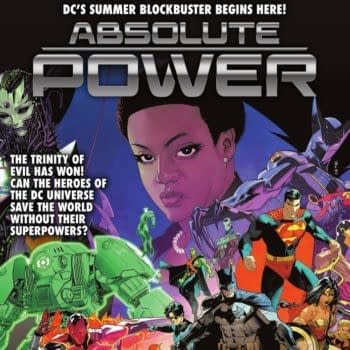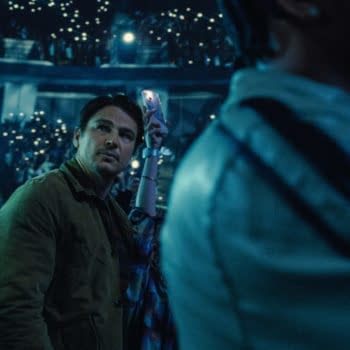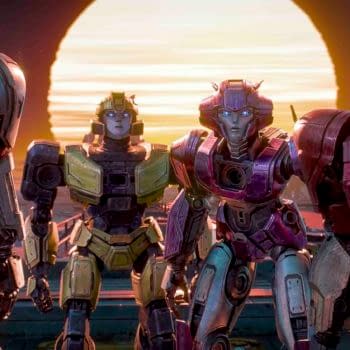Posted in: Movies | Tagged: film
Look! It Moves! by Adi Tantimedh: Dream of a Thousand Musashis
Okay, not actually a thousand, more like about a dozen, but a thousand sounds sexier.
I've been fascinated by legendary samurai Miyamoto Musashi for years, and so, evidently, has Japan. He has been the subject of more books, novels, movies, TV series and manga than I've been able to keep track of.
We actually know very little about the man himself. There are the known facts: he killed his first man in a duel when he was thirteen years old. He never lost a duel. In his twenties, he fought a series of duels with the Yoshioka school, defeating its senior members until only the 12-year-old son was left to head the school, and Musashi killed him too, destroying the school. He was the first swordsman to fight using two swords at once. His most famous duel was with Sasaki Kojiro, whom he brained to death with a boat's wooden oar rather than a sword. He became a renowned artist later in life, specialising in calligraphy and ink painting. He wrote five books on dueling and strategy, including THE BOOK OF FIVE RINGS, which is now read by business people as an essential guide for strategy alongside Sun Tzu's THE ART OF WAR. He lived well into his sixties and died of natural causes rather than in battle, shortly after completing THE BOOK OF FIVE RINGS.
Little is known about the man's personality though much can be inferred from his actions. On top of being a master swordsman, he was also a brilliant and ruthless strategist – many of his duels were worn by his showing up late on purpose, the act of rudeness so pissed off his opponents and unbalanced them that he was able to trip them up with it and kill them. He was a practitioner of Zen Buddhism and Zazen meditation, which means he had a lot of time to think through his approaches to combat and strategy. Beyond that, Musashi has been enough of a blank slate, a tabula rasa into whom various writers could impose different agendas and interpretations, and many of them have. He has been used as a symbol of stoic patriotism in Kenji Mizoguchi's 1944 movie where he helps a pair of orphaned teenagers avenge their samurai father's death at the hands of Sasaki Kojiro. In what's known in the West as 1950s' THE SAMURAI TRILOGY where he's played by Toshiro Mifune, Musashi's story is played as a parable about a beast gradually becoming civilized into a thoughtful samurai fit for society.
The majority of what we know of the Musashi story comes from Eiji Yoshikawa's 1935 novel MUSASHI to the point where some people think it's the true story when it isn't (Mizoguchi's movie doesn't, making up a completely new plot making Sasaki Kojiro the villain who has to face off against Musashi at the end). Musashi's childhood friend, the feckless screw-up Matahachi, was Yoshikawa's fictional creation, as was Musashi's star-crossed sweetheart Otsu. Musashi's epic one-man battle against the 78 samurai of the Yoshioka School is a fiction from the novel and likely never happened in real life, even if this fight forms the centerpiece of the majority of the movies, manga and TV adaptations. Yoshikawa's novel ended with Musashi's duel with Sasaki Kojiro on Ganryu Island, despite known facts about Musashi's life after that up to his death. There were actually novels written about Musashi's life after the duel on Ganryu Island, and those have been adapted into movies and TV shows in Japan as well, but they didn't feature Takahashi, Otsu or the supporting cast from Yoshikawa's novel because they were copyrighted to Yoshikawa.
It really irritates me that THE SAMURAI TRILOGY is praised by Western critics and audiences because I think it's not only the most boring adaptation of the Musashi story, but also the most boring Samurai movies ever made. I think the praise that people in the West heap on it is due to the fact that this is the only version of the Musashi story they've ever seen, and also because it starred Toshiro Mifune in one of his least interesting performances. The camerawork was static and boring, and there was nothing interesting about the framing or choreography of the action at all. It lacks the epic sweep and thematic layering you would find from a director like Kurosawa or Mizoguchi. It's the definition of a hack job, virtually a textbook lesson in how to make the Most Boring movie Ever. Japanese people tend to consider the five-part movie sequence from 1961 to 1965 starring Kinnosuke Nakamura to be the best and definitive movie version of Musashi. These were shot in Cinemascope widescreen with a roving camera that keeps the frame alive and busy. Nakamura's performance was raw, electric and animalistic, and the epic fight with the 78 disciples of the Yoshioka School was staged in a rice field with all the escalating desperation, mess and chaos that might entail, all in widescreen. The Nakaumura movies carried the angry symbolic charge of portraying Musashi as an angry, existential outsider that seemed to anticipate the mood of angry youthful rebellion of the 1960s, which might be why the series is still popular in Japan to this day. Thankfully, this series is finally available on DVD in the US, but no one in America except hardcore fans of samurai movies are even aware of its existence. Nakuamura would go on to play Ogami Itto in the 1970s TV series version of LONE WOLF AND CUB.
The most recent live action version of Musashi was a lavish 2003 TV series produced by NHK, Japan's equivalent of the BBC. It ran for nearly a year and not only adapts Yoshikawa's novel but also continues this fictional Musashi's story past the duel with Sasaki Kojiro, weaving in key events in Japanese history to intersect with Musashi's journey to, in effect, educate and entertain the audience, even using the story to teach the basic tenets of Zen Buddhism and Mindfulness through Musashi's spiritual awakening.

The NHK TV series was partly inspired by the popularity of Takehiko Inoue's manga series VAGABOND, which had already been running a few years by then. After taking over a year off to recover from illness, Inoue has resumed work on the manga series to bring it to its conclusion. VAGABOND is another adaptation of Yoshikawa's novel and, to my mind, the definitive version of the Musashi fiction. Inoue cuts out all the stodgy conformism of the story and concentrates more intensely than any other adapter on the existential loneliness of Musashi, emphasizing the metaphysical dimensions not only of Musashi's Zen Buddhism but also the moments of grace that martial artists can experience, the instant where time slows down and the warrior can see everything – the past that led to that instance, the opponent's blow coming that he will be able to avoid and the opening that will enable him to strike for victory and survival, and time stops being linear where past, present and the possible future converge.
I once came across an untranslated one-volume manga about Musashi by LONE WOLF AND CUB artist Goseki Kojima that tackled his later years, originally published in the 1970s or 1980s. I wish I'd bought it now as I haven't been able to find it again and it's probably out of print. Even anime director Mamoru Oshii, best known for GHOST IN THE SHELL, PATLABOR and AVALON and their cyberpunk themes of Transhumanism and technology, recently made the anime documentary MUSASHI: DREAM OF THE LAST SAMURAI, a meditation on the origins of Musashi's two-swords technique (interestingly, the English-subtitled DVD is available in the UK). I can't keep track of how many anime, manga, TV shows and video games – hell and fan fiction – where Musashi makes a cameo or appearance as a supporting character.
What makes Musashi so popular is that instead of being a character who stood for law, order, the status quo or adherence to Bushido, his essential legend was a loner, an existentialist, an individualist whose only mission was perfection at his craft, whether it was swordplay or Art, and the spaces in between enable him to be all things to all people. Musashi the Myth is the gift that keeps on giving, and I'm sure he's going to outlive us all.
Swinging either one or two swords at lookitmoves@gmail.com
Follow the official LOOK! IT MOVES! twitter feed at http://twitter.com/lookitmoves for thoughts and snark on media and pop culture, stuff for future columns and stuff I may never spend a whole column writing about.
Look! It Moves! © Adisakdi Tantimedh
























